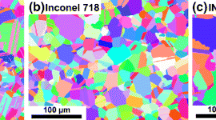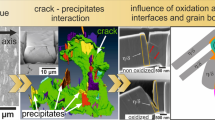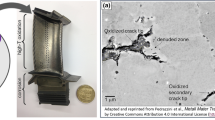Abstract
It has been reported that the minimum observed fatigue lifetimes in numerous structural alloys are dominated by the small-crack growth behavior. While environmental effects on fatigue crack growth behavior of Ni-base superalloys are well documented within the literature, the published research is largely limited to long crack behavior due to the difficulty of measuring small cracks in a vacuum chamber. A testing capability incorporating optical measurement of small fatigue cracks under ultra-high vacuum (~10−9 Torr) and at elevated temperatures has been developed. Optical measurement capabilities have been evaluated under laboratory air conditions to determine crack measurement accuracy. A vacuum fatigue test was then completed at 650 °C on a Ni-base superalloy specimen to quantify the effect of vacuum on the propagation life within the small crack regime. The effectiveness of this test capability and considerations for this technique are discussed.










Similar content being viewed by others
References
U.S. Air Force (2002) Engine structural integrity program, military standard 1783B. Aeronautical Systems Center, Wright-Patterson Air Force Base
Reed RC, Green KA, Caron PG, Fahrmann MG, Huron ES, Woodard SA (2008) Mean vs. life-limiting fatigue behavior of a nickel-base superalloy. Superalloys 2008
Rosenberger AH, Worth BD, Larsen J (1997) Effects of microstructure, temperature and environmental on fatigue crack growth in Ti-46.5AL-3Nb-2Cr-0.2W titanium aluminide. ISSI: Structural intermetallics 1997:555–561
Osinkolu GA, Onofrio G, Marchionni M (2003) Fatigue crack growth in polycrystalline IN 718 superalloy. Mater Sci Eng 356:425–433
Smith HH, Michel DJ (1985) Effect of environment on fatigue crack propagation behavior of alloy 718 at elevated temperatures. Metall Trans A17:370–374
Kirby BR, Beevers CJ (1979) Slow fatigue crack growth and threshold behaviour in air and vacuum of commercial aluminium alloys. Fatigue Eng Mater Struct 1:203–215
Holtz RL, Sadananda K (1997) Fatigue threshold maps of PWA 1480 superalloy single crystal in air and vacuum at room temperature. No. CONF-970980. The Minerals, Metals and Materials Society, Warrendale, PA (United States)
Ghonem H, Foerch R (1991) Frequency effects on fatigue crack growth behavior in a near alpha titanium alloy. Mater Sci Eng A138:69–81
Ghonem H, Nicholas T, Pineau A (1993) Elevated temperature fatigue crack growth in alloy 718–part II: effects of environmental and material variables. Fatigue Fract Eng Mater Struct 16(6):577–590
Gayda J, Gabb TP, Miner RV (1985) Fatigue crack growth propagation of Nickel-Base Superalloys at 650 C. NASA Technical Memo 87150
Zhu SJ, Peng LM, Moriya T, Mutoh Y (2000) Effect of stress ratio on fatigue crack growth in TiAl intermetallics at room and elevated temperatures. Mater Sci Eng A 290:198–206
Davidson DL, Campbell JB (1993) Fatigue crack growth through the lamellar microstructure of an alloy based on TiAl at 25°C and 800°C. Metall Trans 24A:1555–1574
Telesman J, Kantzos P (1988) Fatigue crack growth behavior of a single crystal alloy as observed through an in situ fatigue loading stage. NASA Technical Memo 100863
Petit J (1992) Influence of environment on small fatigue crack growth. Small fatigue cracks, mechanics, mechanisms and applications. Ravichandran KS, Ritchie RO, Murakami Y (eds). Elsevier Pub., Amsterdam, pp. 167–178
Petit J, Mendez J, Berata W, Legendre L, Muller C (1999) Influence of environment on the propagation of short fatigue cracks in a titanium alloy. Short Fatigue Cracks, ESIS 13 (Edited by K. J. Miller and E. R. de los Rios) 1992, Mechanical Engineering Publications, pp. 235–250
Reger M, Remy L (1988) High temperature, low cycle fatigue of IN-100 superalloy I: influence of temperature on the low cycle fatigue behaviour. Mater Sci Eng A 101:47–54
Reger M, Remy L (1988) High temperature, low cycle fatigue of IN-100 superalloy II: influence of frequency and environment at high temperatures. Mater Sci Eng A 101:55–63
Onofrio G, Osinkolu GA, Marchionni M (2001) Fatigue crack growth of UDIMET 720 Li superalloy at elevated temperature. Int J Fatigue 23:887–895
Tanaka Y, Deng Z-Y, Liu Y-F, Masuda C (2003) In situ observation on fatigue crack growth in SCS-6/Ti-15-3 composite at elevated temperatures. Acta Mater 51:6329–6340
Stephens RR, Grabowski L, Hoeppner DW (1993) The effect of temperature on the behaviour of short fatigue cracks in waspaloy using an in situ SEM fatigue apparatus. Int J Fatigue 15(4):273–282
Biallas G, Maier HJ (2007) In-situ fatigue in an environmental scanning electron microscope - Potential and current limitations. Int J Fatigue 29:1413–1425
Grinberg NM (1982) The effect of vacuum on fatigue crack growth. Int J Fatigue 4(2):83–95
Vasudevan AK, Sadananda K, Holtz RL (2005) Analysis of vacuum fatigue crack growth results and its implications. Int J Fatigue 27:1519–1529
Gangloff RP, Slavik DC, Piascik RS, Van Stone RH (1992) Direct current electrical potential measurement of the growth of small cracks. Small-Crack Test Methods 1:116–168
Caton MJ, John R, Porter WJ, Burba ME (2012) Stress ratio effects on small fatigue crack growth in Ti-6Al–4V. Int J Fatigue 38:36–45
Swain MH (1992) Small-crack test methods. ASTM, Philadelphia, pp 34–56
Sunder R, Seetharam A, Bhaskaran TA (1984) Cycle counting for fatigue crack growth analysis. Int J Fatigue 6:147–156
Park SC, Park MK, Kang MG (2003) Super-resolution image reconstruction: a technical overview. Signal Process Mag IEEE 20(3):21–36
Acknowledgments
This work was performed at the Air Force Research Laboratory, Materials and Manufacturing Directorate, AFRL/RXCM, Wright Patterson Air Force Base, OH. Partial financial support from the AFOSR Structural Mechanics Program (Project # 2306-6M2AL8), Dr. David Stargel, program manager, is gratefully acknowledged. Two of the authors (BTG, MEB) would like to acknowledge funding from the Dayton Area Graduate Studies Institute (DAGSI) fellowship. Two of the authors were partially supported under onsite Air Force contracts FA8650-07-D-5800 (SKJ and CJS). Technical assistance in experimental design and setup from M. Ruddell and P. Blosser, both of the University of Dayton Research Institute (UDRI) is appreciated.
Author information
Authors and Affiliations
Corresponding author
Rights and permissions
About this article
Cite this article
Gockel, B.T., Caton, M.J., Jha, S.K. et al. Developing the Capability to Monitor Small Fatigue Crack Growth Under Elevated Temperature, Ultra-High Vacuum Conditions. Exp Mech 55, 951–961 (2015). https://doi.org/10.1007/s11340-015-9998-z
Received:
Accepted:
Published:
Issue Date:
DOI: https://doi.org/10.1007/s11340-015-9998-z




